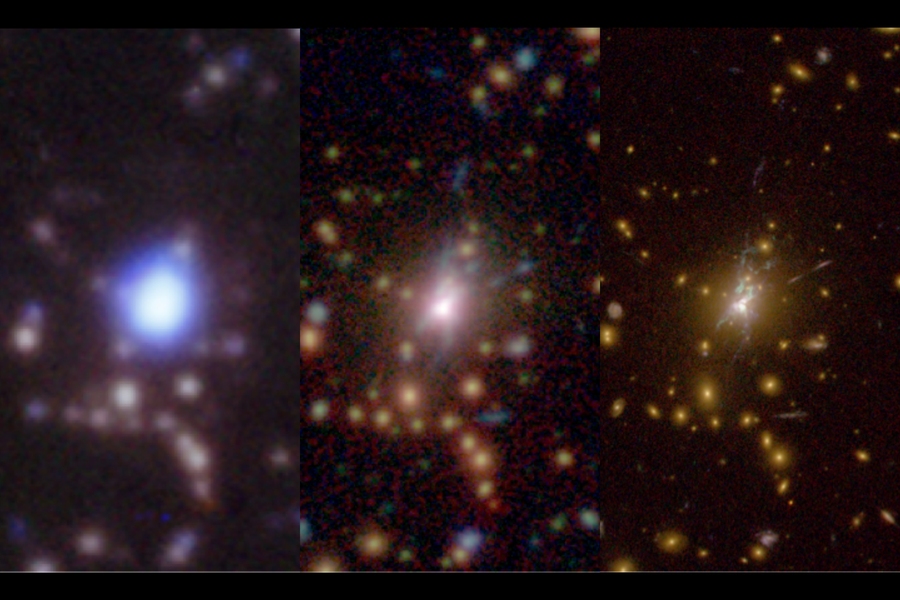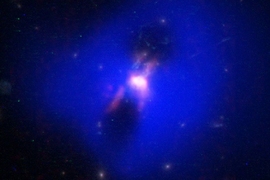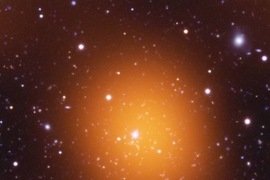From the very beginning, it was clear that the Phoenix cluster was different from other galaxy clusters. When assistant professor of physics Michael McDonald looked at the first image of the Phoenix cluster taken by the Magellan Telescope in Chile, he saw an unexpected hazy circle of blue.
Galaxy clusters like Phoenix are, as the name suggests, a cluster of hundreds or even thousands of galaxies held together by gravity and permeated with dark matter and hot gas. When the hot gas cools, star formation happens. Given the amount of hot gas in galaxy clusters, astronomers expected to find large nurseries of young stars. Instead, they found older stars, which usually glow red, and a black hole at the center of the cluster pumping out energy, keeping the gas too hot for explosive star formation.
Most clusters appear the same when observed through a telescope. “When we look at the center of clusters, we see galaxies that are spherical or football-shaped and red,” says McDonald, who is also a researcher at the MIT Kavli Institute for Astrophysics and Space Research (MKI).
The blue light McDonald saw in Phoenix, however, is a telltale sign of a young star, which burns hotter and brighter. Confirming that the blue light was the result of new star formation would take advances in the quality of data and access to three powerful telescopes to figure out what makes the Phoenix cluster unique.
Telescope trifecta
McDonald hypothesized that the hazy blue light at the center of the Phoenix cluster was due to millions of newly formed stars, but there was another possible explanation. “It could be that there is a single blue point that is smeared because we don’t have the resolution to see it,” he explains. That blue point of light could be a quasar, a type of black hole that expels matter, heating the galaxy’s gas.
In 2015, three years after that first image was taken, McDonald and his colleagues published new, higher-resolution images of Phoenix collected from more powerful telescopes. “It’s like putting your glasses on,” McDonald says. This allowed them to see that the blue point at the center of Phoenix was not really a single point, but rather a group of blue filaments. “That’s what you would expect if the gas is condensing,” he explains. Hot gas doesn’t cool uniformly in a galaxy; some parts will cool more quickly, forming highways of cool gas where new stars can rapidly form.
Now, four years after the second set of images were taken, McDonald and his collaborators have released an even more detailed image of the Phoenix cluster, taken by NASA’s Hubble Space Telescope, which is orbiting the Earth. The image was published in a recent issue of The Astronomical Journal and shows the central galaxy in greater detail with wispy filaments where new stars are concentrated. McDonald's coauthors include MKI research scientist Matthew Bayliss, assistant professor of physics Erin Kara, and physics graduate student Taweewat Somboonpanyakul.
“The Hubble data increased — by a factor of 10 — the detail we can see,” says McDonald. But the Hubble Space Telescope is just one of the telescopes used. The team also collected X-ray data with NASA’s Chandra X-ray Observatory, which orbits Earth, and radio data using the National Science Foundation’s Karl Jansky Very Large Array (VLA) in New Mexico. It was this trifecta of telescopes that allowed them to figure out why Phoenix is singular among the hundreds of known galaxy clusters.
Unlike other galaxy clusters, the hot gas in the Phoenix cluster is cooling rapidly, nearly at the expected rate for gas not affected by bursts of energy from a black hole. McDonald compares galaxy clusters to a cup of coffee. “It’s a 10-million-degree cup of coffee, but even a 10-million-degree cup of coffee is going to cool,” he explains. As the gas cools, star formation happens more rapidly. Most galaxy clusters, however, behave more like a cup of coffee on a warming plate; no matter how much time passes, the cup of coffee will never be fully cool. “The warmer is the black hole in the center of the galaxy, and every cluster observed has a warm interior.”
Phoenix is different. The black hole at its center isn’t able to keep the hot gas in the galaxy from fully cooling. It’s as if you had placed your 10-million-degree cup of coffee on the counter rather than the warmer, allowing it to cool enough to form millions of young, shimmery blue stars. “This rapid cooling of the intracluster gas is a phenomenon that was predicted nearly 40 years ago, but is apparently so uncommon that it has only now been witnessed for the first time,” says McDonald.
What makes this phenomenon so uncommon is still up in the air. “One theory is that every cluster will go through a phase like this for a short period of time,” making this phenomenon equivalent to a star growth spurt, says McDonald. But he isn’t sure about this explanation. “Even if stars stopped forming now, the blue stars hang around for 50 to 100 million years and we would see evidence that this had happened in other clusters,” he explains. Most likely, McDonald believes, this is a phenomenon that is not only rare, but also needs just right conditions to occur. When it does occur, it changes our understanding of astrophysical phenomena.
Time is money
For McDonald, these results, particularly the progression of optical images of the Phoenix cluster, are a perfect representation of how science progresses. “We start with this really low-quality data and try to imagine what could give us that image,” he explains. The hard part is getting follow-up data.
“The reason there’s a gap between 2015 and 2019 is because we had to convince three different panels of three different telescopes to invest a lot of time,” says McDonald. Their team got 167 hours of Chandra — among the largest projects they approved in 2016 — 12 orbits (20 hours) of Hubble, and for the VLA not only were they given 27.5 hours on the radio array, but the team also convinced the VLA’s panel to point the telescope at the horizon, which brings the telescope's dishes precipitously close to scraping the ground. Convincing panels is like convincing grant reviewers to fund your research, with one difference: “Instead of awarding money, they’re awarding telescope time,” says McDonald.
Time at all three of these telescopes is a hot commodity that researchers can’t afford to spend on projects that are less than a sure bet. “So you do a pilot study, and if the results are encouraging, you invest a little bit more resources and a little more time,” says McDonald. “If the results still look good, now I’ll dump all my resources into this because I know it’s a good avenue, and then you get the big payoff.”
McDonald knows exactly how he’s going to decorate his office at MKI now that the third Phoenix cluster paper has come out. “My plan is to have those three pictures blown up and hung right there on my wall,” he says, gesturing to a corner of his office. “Because just these three images tell the story of how we do science.”








